VoIP System Design and Analysis
VerifiedAdded on 2020/02/14
|14
|2496
|166
AI Summary
This assignment analyzes the design of a VoIP system, focusing on its implementation using SIP and H.323 protocols. It delves into bandwidth calculations for different branches within the system, highlighting the efficiency of VoIP compared to traditional PSTN networks. The analysis underscores the benefits of VoIP in small business environments, emphasizing its flexibility, reliability, and QoS support.
Contribute Materials
Your contribution can guide someone’s learning journey. Share your
documents today.

Design, Implementation and Evaluation of Voice Over IP Network for Small Business 1
Design, Implementation and Evaluation of Voice Over IP
Network for small business
Student’s name:
Instructor’s Name:
Date:
Design, Implementation and Evaluation of Voice Over IP
Network for small business
Student’s name:
Instructor’s Name:
Date:
Secure Best Marks with AI Grader
Need help grading? Try our AI Grader for instant feedback on your assignments.

VOIP PROJECT 2
Contents
Abstract.......................................................................................................................................................3
Introduction and Background Study............................................................................................................3
Related Research [1][2]...............................................................................................................................3
PROJECT DESIGN [3][5]................................................................................................................................5
SIP Components and Messages [5]..............................................................................................................6
Signaling......................................................................................................................................................7
Gateway Control Protocols..........................................................................................................................8
Materials and Methods [4][2]......................................................................................................................9
Network Design Specification....................................................................................................................10
Analysis of Project Data.............................................................................................................................11
VoIP Calculations across Project............................................................................................................11
Link Traffic analysis................................................................................................................................11
Conclusion.................................................................................................................................................13
References.................................................................................................................................................14
Contents
Abstract.......................................................................................................................................................3
Introduction and Background Study............................................................................................................3
Related Research [1][2]...............................................................................................................................3
PROJECT DESIGN [3][5]................................................................................................................................5
SIP Components and Messages [5]..............................................................................................................6
Signaling......................................................................................................................................................7
Gateway Control Protocols..........................................................................................................................8
Materials and Methods [4][2]......................................................................................................................9
Network Design Specification....................................................................................................................10
Analysis of Project Data.............................................................................................................................11
VoIP Calculations across Project............................................................................................................11
Link Traffic analysis................................................................................................................................11
Conclusion.................................................................................................................................................13
References.................................................................................................................................................14
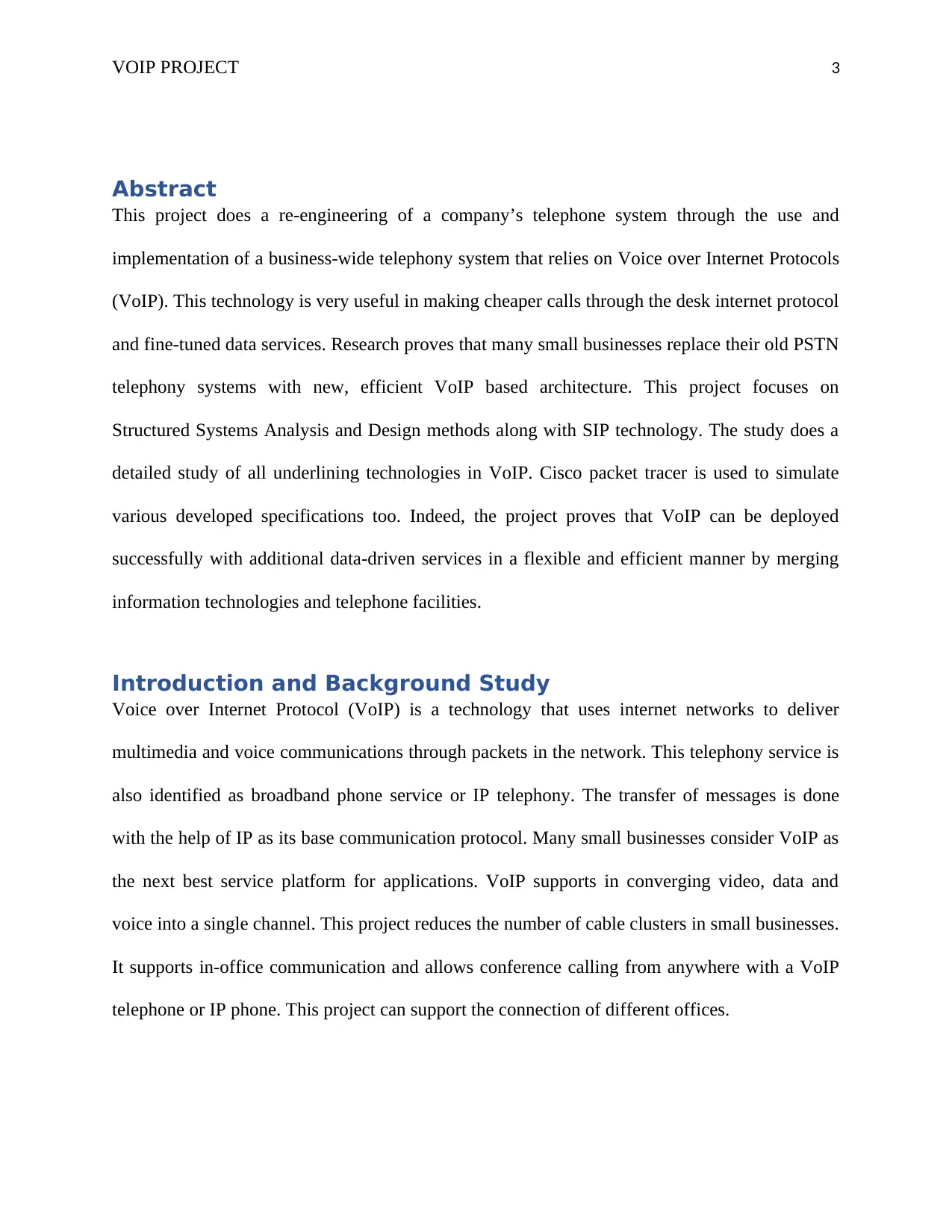
VOIP PROJECT 3
Abstract
This project does a re-engineering of a company’s telephone system through the use and
implementation of a business-wide telephony system that relies on Voice over Internet Protocols
(VoIP). This technology is very useful in making cheaper calls through the desk internet protocol
and fine-tuned data services. Research proves that many small businesses replace their old PSTN
telephony systems with new, efficient VoIP based architecture. This project focuses on
Structured Systems Analysis and Design methods along with SIP technology. The study does a
detailed study of all underlining technologies in VoIP. Cisco packet tracer is used to simulate
various developed specifications too. Indeed, the project proves that VoIP can be deployed
successfully with additional data-driven services in a flexible and efficient manner by merging
information technologies and telephone facilities.
Introduction and Background Study
Voice over Internet Protocol (VoIP) is a technology that uses internet networks to deliver
multimedia and voice communications through packets in the network. This telephony service is
also identified as broadband phone service or IP telephony. The transfer of messages is done
with the help of IP as its base communication protocol. Many small businesses consider VoIP as
the next best service platform for applications. VoIP supports in converging video, data and
voice into a single channel. This project reduces the number of cable clusters in small businesses.
It supports in-office communication and allows conference calling from anywhere with a VoIP
telephone or IP phone. This project can support the connection of different offices.
Abstract
This project does a re-engineering of a company’s telephone system through the use and
implementation of a business-wide telephony system that relies on Voice over Internet Protocols
(VoIP). This technology is very useful in making cheaper calls through the desk internet protocol
and fine-tuned data services. Research proves that many small businesses replace their old PSTN
telephony systems with new, efficient VoIP based architecture. This project focuses on
Structured Systems Analysis and Design methods along with SIP technology. The study does a
detailed study of all underlining technologies in VoIP. Cisco packet tracer is used to simulate
various developed specifications too. Indeed, the project proves that VoIP can be deployed
successfully with additional data-driven services in a flexible and efficient manner by merging
information technologies and telephone facilities.
Introduction and Background Study
Voice over Internet Protocol (VoIP) is a technology that uses internet networks to deliver
multimedia and voice communications through packets in the network. This telephony service is
also identified as broadband phone service or IP telephony. The transfer of messages is done
with the help of IP as its base communication protocol. Many small businesses consider VoIP as
the next best service platform for applications. VoIP supports in converging video, data and
voice into a single channel. This project reduces the number of cable clusters in small businesses.
It supports in-office communication and allows conference calling from anywhere with a VoIP
telephone or IP phone. This project can support the connection of different offices.
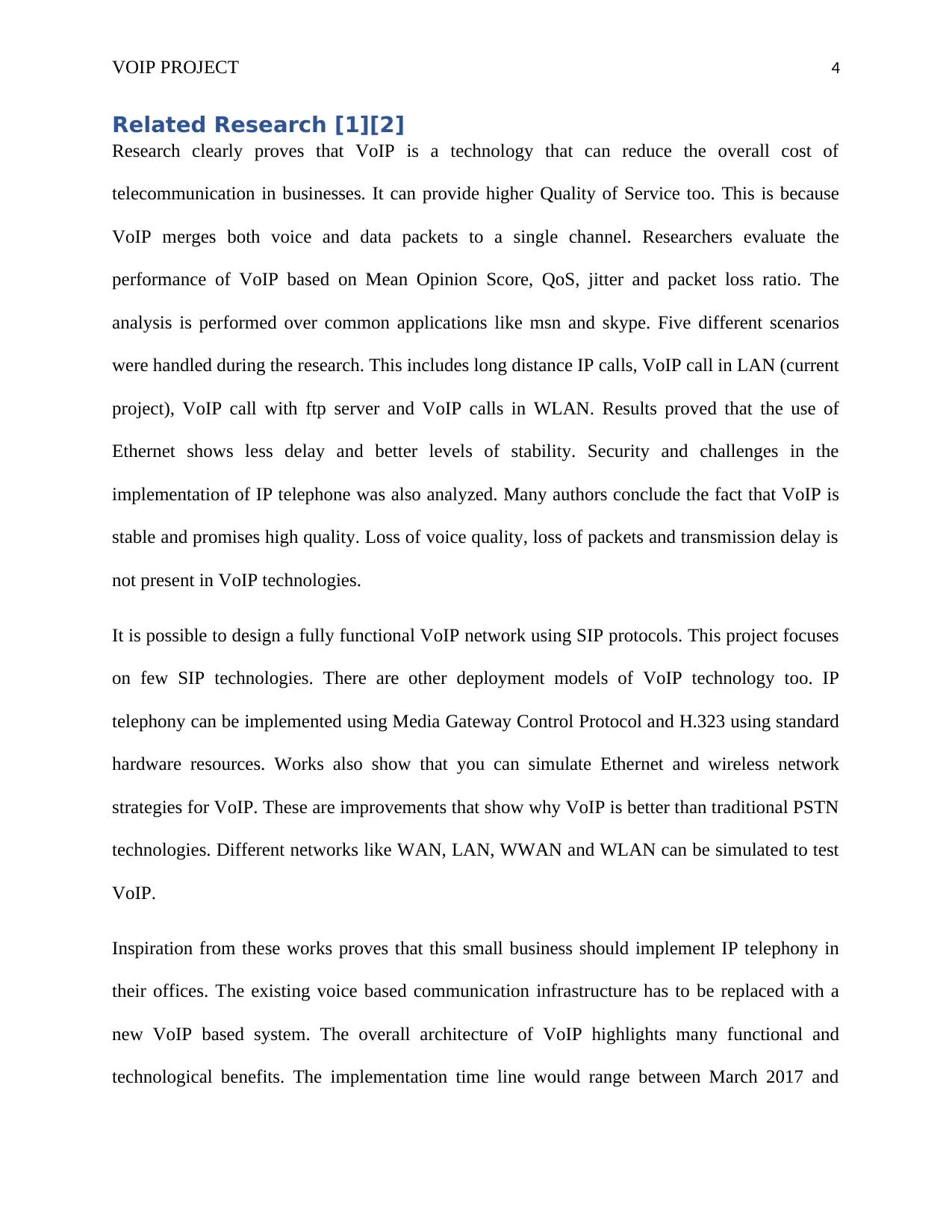
VOIP PROJECT 4
Related Research [1][2]
Research clearly proves that VoIP is a technology that can reduce the overall cost of
telecommunication in businesses. It can provide higher Quality of Service too. This is because
VoIP merges both voice and data packets to a single channel. Researchers evaluate the
performance of VoIP based on Mean Opinion Score, QoS, jitter and packet loss ratio. The
analysis is performed over common applications like msn and skype. Five different scenarios
were handled during the research. This includes long distance IP calls, VoIP call in LAN (current
project), VoIP call with ftp server and VoIP calls in WLAN. Results proved that the use of
Ethernet shows less delay and better levels of stability. Security and challenges in the
implementation of IP telephone was also analyzed. Many authors conclude the fact that VoIP is
stable and promises high quality. Loss of voice quality, loss of packets and transmission delay is
not present in VoIP technologies.
It is possible to design a fully functional VoIP network using SIP protocols. This project focuses
on few SIP technologies. There are other deployment models of VoIP technology too. IP
telephony can be implemented using Media Gateway Control Protocol and H.323 using standard
hardware resources. Works also show that you can simulate Ethernet and wireless network
strategies for VoIP. These are improvements that show why VoIP is better than traditional PSTN
technologies. Different networks like WAN, LAN, WWAN and WLAN can be simulated to test
VoIP.
Inspiration from these works proves that this small business should implement IP telephony in
their offices. The existing voice based communication infrastructure has to be replaced with a
new VoIP based system. The overall architecture of VoIP highlights many functional and
technological benefits. The implementation time line would range between March 2017 and
Related Research [1][2]
Research clearly proves that VoIP is a technology that can reduce the overall cost of
telecommunication in businesses. It can provide higher Quality of Service too. This is because
VoIP merges both voice and data packets to a single channel. Researchers evaluate the
performance of VoIP based on Mean Opinion Score, QoS, jitter and packet loss ratio. The
analysis is performed over common applications like msn and skype. Five different scenarios
were handled during the research. This includes long distance IP calls, VoIP call in LAN (current
project), VoIP call with ftp server and VoIP calls in WLAN. Results proved that the use of
Ethernet shows less delay and better levels of stability. Security and challenges in the
implementation of IP telephone was also analyzed. Many authors conclude the fact that VoIP is
stable and promises high quality. Loss of voice quality, loss of packets and transmission delay is
not present in VoIP technologies.
It is possible to design a fully functional VoIP network using SIP protocols. This project focuses
on few SIP technologies. There are other deployment models of VoIP technology too. IP
telephony can be implemented using Media Gateway Control Protocol and H.323 using standard
hardware resources. Works also show that you can simulate Ethernet and wireless network
strategies for VoIP. These are improvements that show why VoIP is better than traditional PSTN
technologies. Different networks like WAN, LAN, WWAN and WLAN can be simulated to test
VoIP.
Inspiration from these works proves that this small business should implement IP telephony in
their offices. The existing voice based communication infrastructure has to be replaced with a
new VoIP based system. The overall architecture of VoIP highlights many functional and
technological benefits. The implementation time line would range between March 2017 and
Secure Best Marks with AI Grader
Need help grading? Try our AI Grader for instant feedback on your assignments.
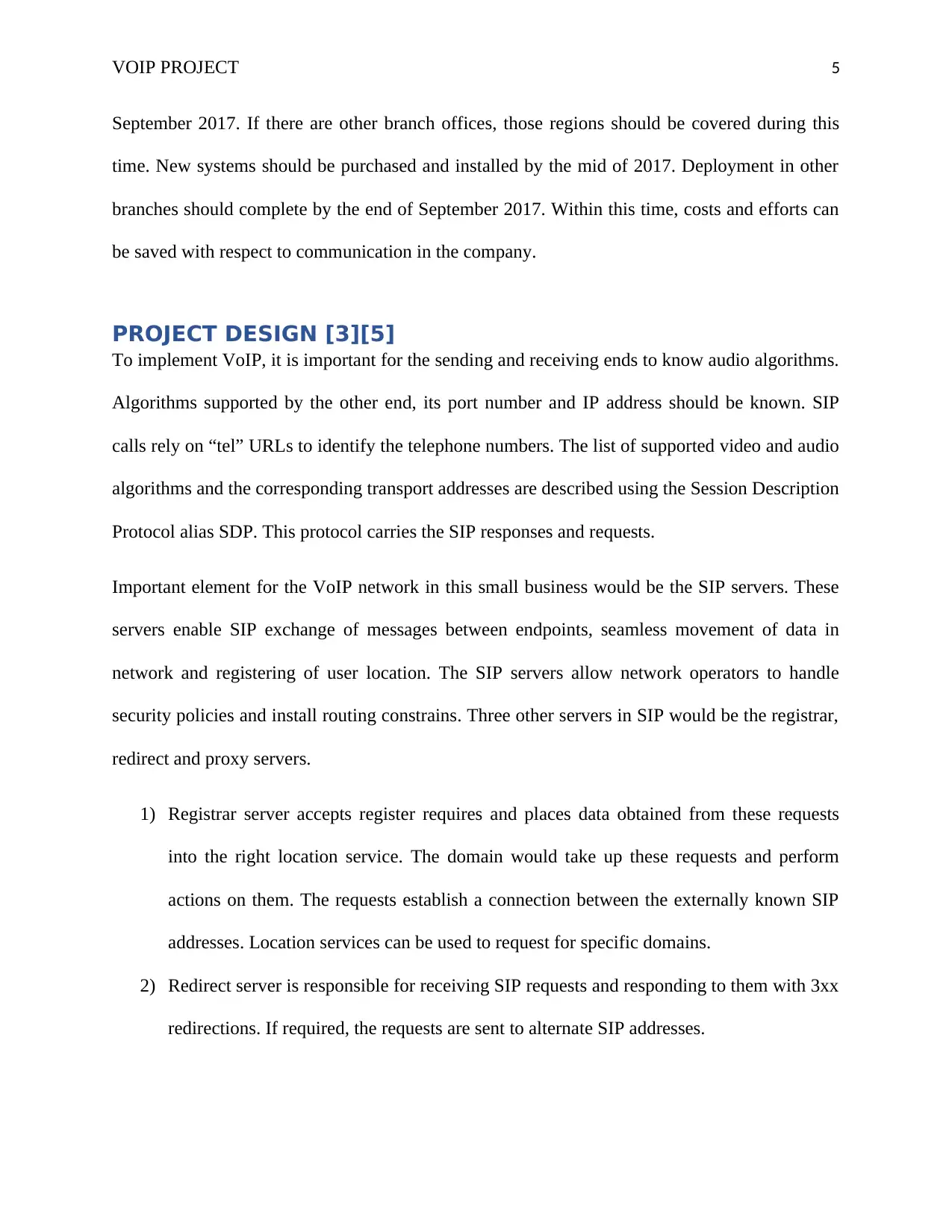
VOIP PROJECT 5
September 2017. If there are other branch offices, those regions should be covered during this
time. New systems should be purchased and installed by the mid of 2017. Deployment in other
branches should complete by the end of September 2017. Within this time, costs and efforts can
be saved with respect to communication in the company.
PROJECT DESIGN [3][5]
To implement VoIP, it is important for the sending and receiving ends to know audio algorithms.
Algorithms supported by the other end, its port number and IP address should be known. SIP
calls rely on “tel” URLs to identify the telephone numbers. The list of supported video and audio
algorithms and the corresponding transport addresses are described using the Session Description
Protocol alias SDP. This protocol carries the SIP responses and requests.
Important element for the VoIP network in this small business would be the SIP servers. These
servers enable SIP exchange of messages between endpoints, seamless movement of data in
network and registering of user location. The SIP servers allow network operators to handle
security policies and install routing constrains. Three other servers in SIP would be the registrar,
redirect and proxy servers.
1) Registrar server accepts register requires and places data obtained from these requests
into the right location service. The domain would take up these requests and perform
actions on them. The requests establish a connection between the externally known SIP
addresses. Location services can be used to request for specific domains.
2) Redirect server is responsible for receiving SIP requests and responding to them with 3xx
redirections. If required, the requests are sent to alternate SIP addresses.
September 2017. If there are other branch offices, those regions should be covered during this
time. New systems should be purchased and installed by the mid of 2017. Deployment in other
branches should complete by the end of September 2017. Within this time, costs and efforts can
be saved with respect to communication in the company.
PROJECT DESIGN [3][5]
To implement VoIP, it is important for the sending and receiving ends to know audio algorithms.
Algorithms supported by the other end, its port number and IP address should be known. SIP
calls rely on “tel” URLs to identify the telephone numbers. The list of supported video and audio
algorithms and the corresponding transport addresses are described using the Session Description
Protocol alias SDP. This protocol carries the SIP responses and requests.
Important element for the VoIP network in this small business would be the SIP servers. These
servers enable SIP exchange of messages between endpoints, seamless movement of data in
network and registering of user location. The SIP servers allow network operators to handle
security policies and install routing constrains. Three other servers in SIP would be the registrar,
redirect and proxy servers.
1) Registrar server accepts register requires and places data obtained from these requests
into the right location service. The domain would take up these requests and perform
actions on them. The requests establish a connection between the externally known SIP
addresses. Location services can be used to request for specific domains.
2) Redirect server is responsible for receiving SIP requests and responding to them with 3xx
redirections. If required, the requests are sent to alternate SIP addresses.

VOIP PROJECT 6
3) Proxy server handles the standard SIP proxies. These are elements that route all SIP
requests to pre-defined User Agent Servers alias UAS. SIP responses are route to User
Agent Clients (UAC). Each request goes through a series of routing decisions that tend to
modify requests before forwarding packets to other elements.
SIP Components and Messages [5]
Two important components in this VoIP network would be the user servers and agents. These are
straightforward components. The SIP user agents contain a User Agent Client and User Agent
Server. The components are carefully identified using a SIP Uniform Resource Locator. This
technology is very similar to the one used in e-mail systems. The user component has a
telephone number and name. The host component has a numeric network address and domain
name. The messages can be requests from the client to server or a response. The flow of
messages in this VoIP design would be as follows:
1) Invite user or service to participate in a session
2) The client will receive an acknowledgement if the invite request was received.
3) Options can be used by the server to know details of its capabilities
3) Proxy server handles the standard SIP proxies. These are elements that route all SIP
requests to pre-defined User Agent Servers alias UAS. SIP responses are route to User
Agent Clients (UAC). Each request goes through a series of routing decisions that tend to
modify requests before forwarding packets to other elements.
SIP Components and Messages [5]
Two important components in this VoIP network would be the user servers and agents. These are
straightforward components. The SIP user agents contain a User Agent Client and User Agent
Server. The components are carefully identified using a SIP Uniform Resource Locator. This
technology is very similar to the one used in e-mail systems. The user component has a
telephone number and name. The host component has a numeric network address and domain
name. The messages can be requests from the client to server or a response. The flow of
messages in this VoIP design would be as follows:
1) Invite user or service to participate in a session
2) The client will receive an acknowledgement if the invite request was received.
3) Options can be used by the server to know details of its capabilities
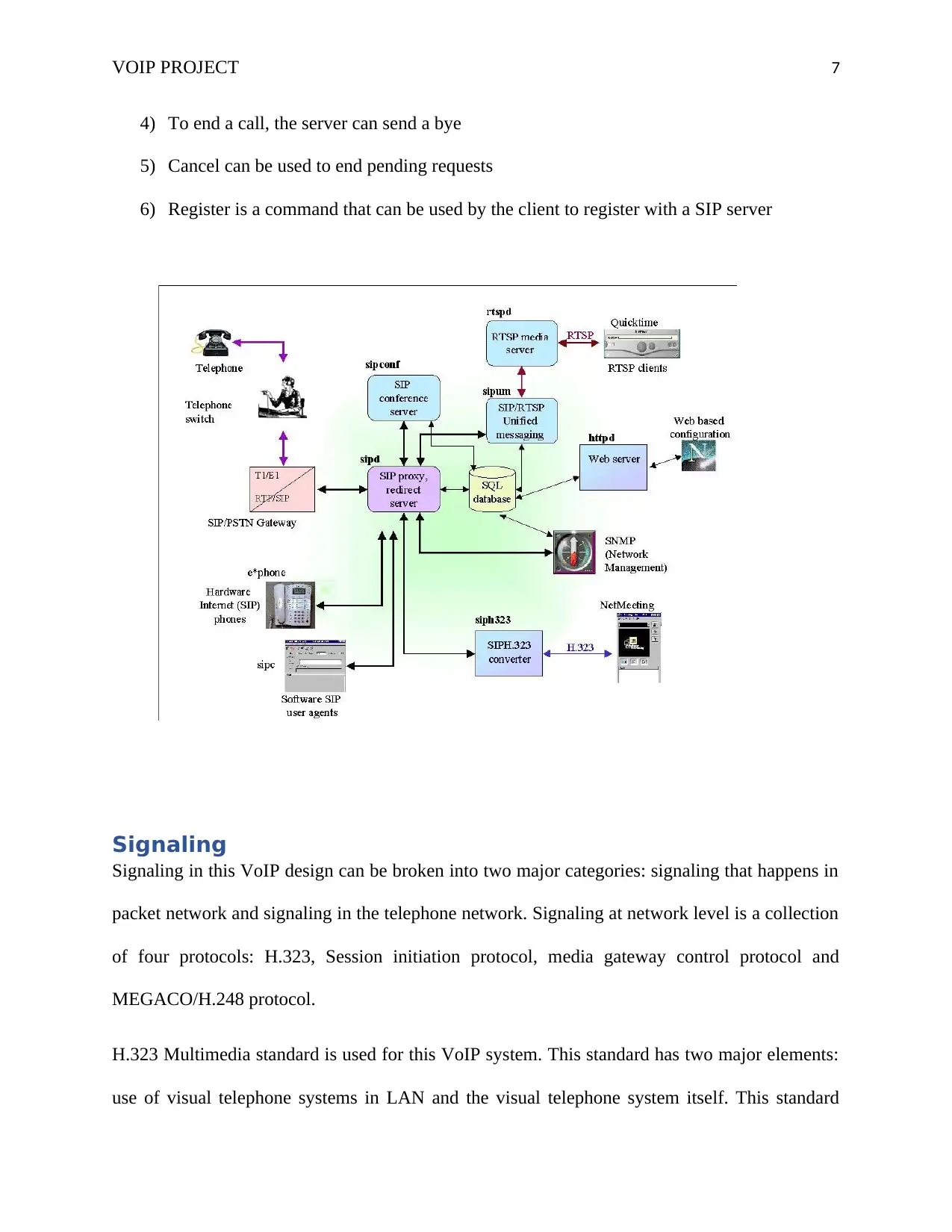
VOIP PROJECT 7
4) To end a call, the server can send a bye
5) Cancel can be used to end pending requests
6) Register is a command that can be used by the client to register with a SIP server
Signaling
Signaling in this VoIP design can be broken into two major categories: signaling that happens in
packet network and signaling in the telephone network. Signaling at network level is a collection
of four protocols: H.323, Session initiation protocol, media gateway control protocol and
MEGACO/H.248 protocol.
H.323 Multimedia standard is used for this VoIP system. This standard has two major elements:
use of visual telephone systems in LAN and the visual telephone system itself. This standard
4) To end a call, the server can send a bye
5) Cancel can be used to end pending requests
6) Register is a command that can be used by the client to register with a SIP server
Signaling
Signaling in this VoIP design can be broken into two major categories: signaling that happens in
packet network and signaling in the telephone network. Signaling at network level is a collection
of four protocols: H.323, Session initiation protocol, media gateway control protocol and
MEGACO/H.248 protocol.
H.323 Multimedia standard is used for this VoIP system. This standard has two major elements:
use of visual telephone systems in LAN and the visual telephone system itself. This standard
Paraphrase This Document
Need a fresh take? Get an instant paraphrase of this document with our AI Paraphraser

H.323 Terminal
H.323
Gatekeeper
H.323 Gateway H.323 Terminal H.323 Terminal
H.323 MCU
Packet Based Network
VOIP PROJECT 8
assumes that the transmission medium used for the communication does not promise guaranteed
delivery of packets. Thus, it incorporates many security measures to prevent data loss and make
sure data is transmitted between mediums perfectly. The H.323 standard works efficiently with
WAN and LAN network types. Also, it does not compromise on Quality of Service. H.323 is a
collection of few other standards too. This includes H.245 for terminal control functionalities,
H.225 for terminal to gatekeeper functionalities and Q.932 for call signaling functionalities.
Since the business requires data conferencing, T.120 in H.323 proves to be useful. This standard
is sufficient to share still images and white boarding applications.
H.323 has call signaling defined in it to establish calls, to determine the current status of various
endpoints and to request for amendments in the call bandwidth. The entities follow two levels of
addressing: TSAP identifier and a network address. The setup has a gatekeeper. This is a device
that controls network access. All endpoints in the network are initialized to the gatekeeper. There
are logical channels to take handle status, admissions and registration.
H.323
Gatekeeper
H.323 Gateway H.323 Terminal H.323 Terminal
H.323 MCU
Packet Based Network
VOIP PROJECT 8
assumes that the transmission medium used for the communication does not promise guaranteed
delivery of packets. Thus, it incorporates many security measures to prevent data loss and make
sure data is transmitted between mediums perfectly. The H.323 standard works efficiently with
WAN and LAN network types. Also, it does not compromise on Quality of Service. H.323 is a
collection of few other standards too. This includes H.245 for terminal control functionalities,
H.225 for terminal to gatekeeper functionalities and Q.932 for call signaling functionalities.
Since the business requires data conferencing, T.120 in H.323 proves to be useful. This standard
is sufficient to share still images and white boarding applications.
H.323 has call signaling defined in it to establish calls, to determine the current status of various
endpoints and to request for amendments in the call bandwidth. The entities follow two levels of
addressing: TSAP identifier and a network address. The setup has a gatekeeper. This is a device
that controls network access. All endpoints in the network are initialized to the gatekeeper. There
are logical channels to take handle status, admissions and registration.

VOIP PROJECT 9
Gateway Control Protocols
This VoIP design uses MGCP as its gateway control protocol. This protocol is necessary when
two dissimilar networks communicate with one another. It has functionalities to control
operations and establish stable paths between dissimilar networks. This protocol has commands
and parameters that are carefully passed between the telephone gateway and call agent. A
master/slave strategy is used to control the way commands are sent between the gateway and call
agent. These commands and data are sent in the form of signals or events. For example, a simple
event would be an IP phone going off-hook and a signal could be an application of a dial tone to
a specific endpoint. These signals and events can be grouped into simple packages. Examples for
VoIP packages would be the trunk, DTMF, RTP, Network Access Server, script and
Announcement server.
Materials and Methods [4][2]
The VoIP for this small business is established using the structured systems analysis and design
methodology. Two important physical connectivity methods are used during the research:
1) A Cisco IP Softphone is considered. JTAOP application can be run on a computer, where
the phone is used. This technology removes the need for separate handsets.
2) Likewise, an IP phone can be connected to a data device and a switched Ethernet port. A
single port can be used to ensure connectivity to both the endpoints (devices).
Materials for the project would be as follows:
1) A Cisco Packet tracer, to run simulation and specification of the system’s behavior
2) Cisco Router 2811
3) Cisco 6500 Layer 3 switch
Gateway Control Protocols
This VoIP design uses MGCP as its gateway control protocol. This protocol is necessary when
two dissimilar networks communicate with one another. It has functionalities to control
operations and establish stable paths between dissimilar networks. This protocol has commands
and parameters that are carefully passed between the telephone gateway and call agent. A
master/slave strategy is used to control the way commands are sent between the gateway and call
agent. These commands and data are sent in the form of signals or events. For example, a simple
event would be an IP phone going off-hook and a signal could be an application of a dial tone to
a specific endpoint. These signals and events can be grouped into simple packages. Examples for
VoIP packages would be the trunk, DTMF, RTP, Network Access Server, script and
Announcement server.
Materials and Methods [4][2]
The VoIP for this small business is established using the structured systems analysis and design
methodology. Two important physical connectivity methods are used during the research:
1) A Cisco IP Softphone is considered. JTAOP application can be run on a computer, where
the phone is used. This technology removes the need for separate handsets.
2) Likewise, an IP phone can be connected to a data device and a switched Ethernet port. A
single port can be used to ensure connectivity to both the endpoints (devices).
Materials for the project would be as follows:
1) A Cisco Packet tracer, to run simulation and specification of the system’s behavior
2) Cisco Router 2811
3) Cisco 6500 Layer 3 switch
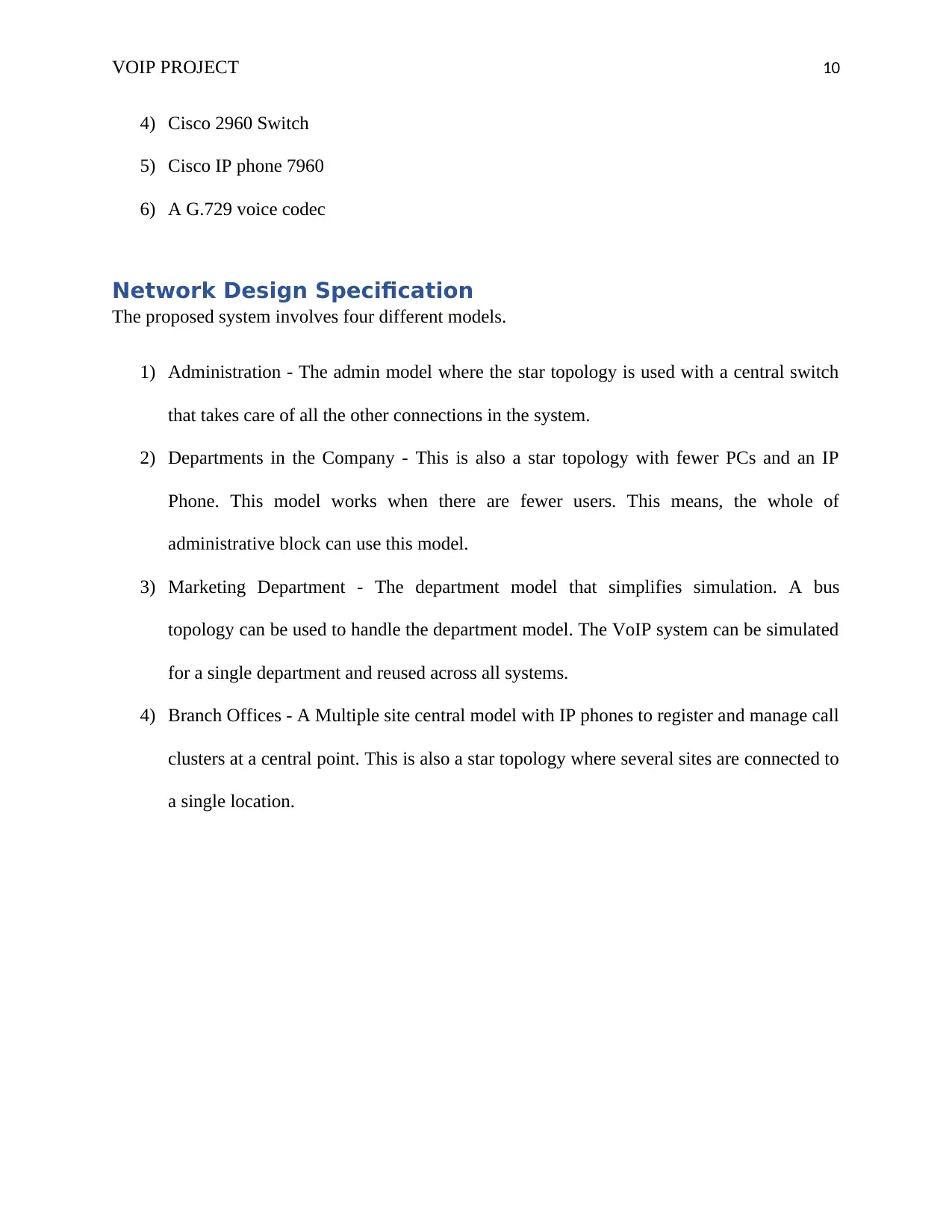
VOIP PROJECT 10
4) Cisco 2960 Switch
5) Cisco IP phone 7960
6) A G.729 voice codec
Network Design Specification
The proposed system involves four different models.
1) Administration - The admin model where the star topology is used with a central switch
that takes care of all the other connections in the system.
2) Departments in the Company - This is also a star topology with fewer PCs and an IP
Phone. This model works when there are fewer users. This means, the whole of
administrative block can use this model.
3) Marketing Department - The department model that simplifies simulation. A bus
topology can be used to handle the department model. The VoIP system can be simulated
for a single department and reused across all systems.
4) Branch Offices - A Multiple site central model with IP phones to register and manage call
clusters at a central point. This is also a star topology where several sites are connected to
a single location.
4) Cisco 2960 Switch
5) Cisco IP phone 7960
6) A G.729 voice codec
Network Design Specification
The proposed system involves four different models.
1) Administration - The admin model where the star topology is used with a central switch
that takes care of all the other connections in the system.
2) Departments in the Company - This is also a star topology with fewer PCs and an IP
Phone. This model works when there are fewer users. This means, the whole of
administrative block can use this model.
3) Marketing Department - The department model that simplifies simulation. A bus
topology can be used to handle the department model. The VoIP system can be simulated
for a single department and reused across all systems.
4) Branch Offices - A Multiple site central model with IP phones to register and manage call
clusters at a central point. This is also a star topology where several sites are connected to
a single location.
Secure Best Marks with AI Grader
Need help grading? Try our AI Grader for instant feedback on your assignments.
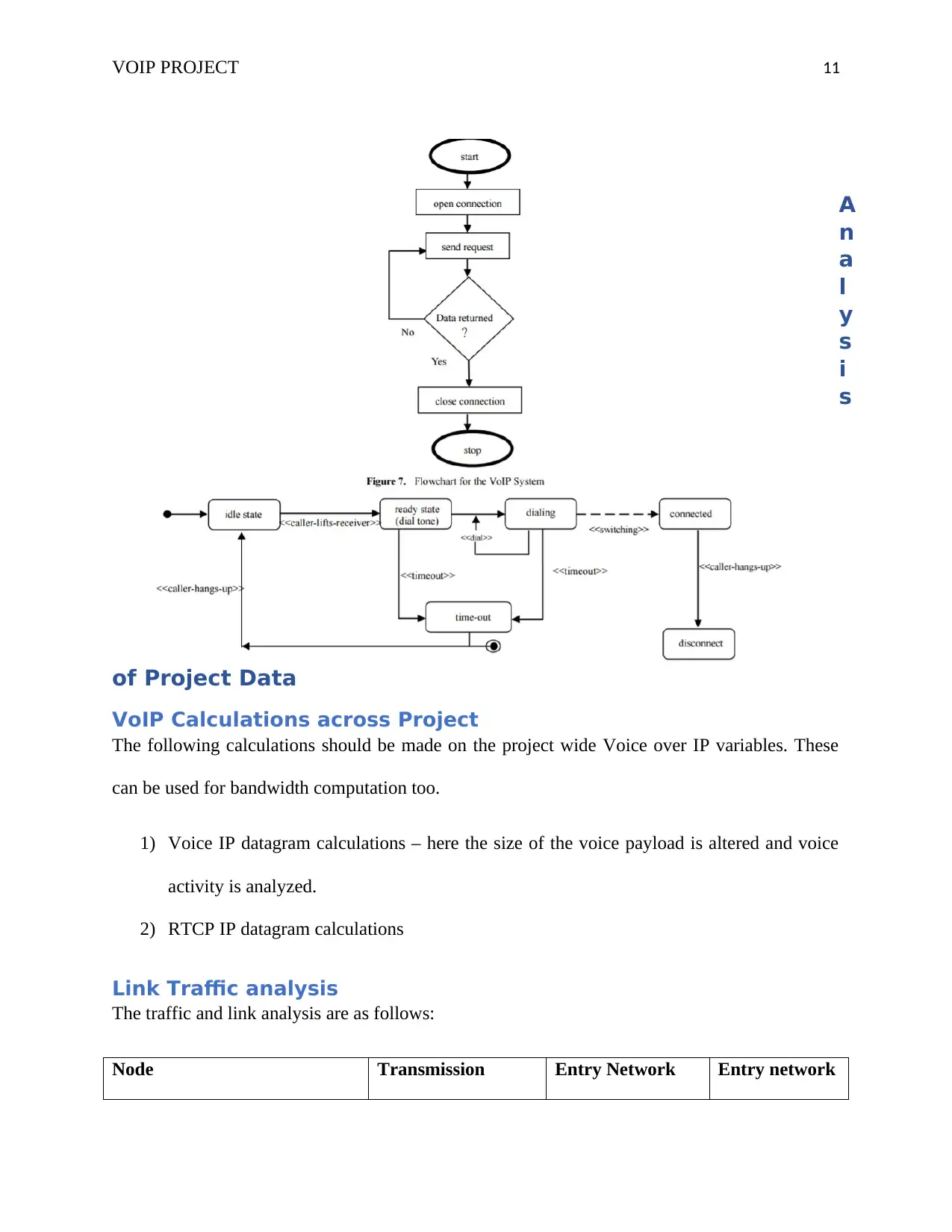
VOIP PROJECT 11
A
n
a
l
y
s
i
s
of Project Data
VoIP Calculations across Project
The following calculations should be made on the project wide Voice over IP variables. These
can be used for bandwidth computation too.
1) Voice IP datagram calculations – here the size of the voice payload is altered and voice
activity is analyzed.
2) RTCP IP datagram calculations
Link Traffic analysis
The traffic and link analysis are as follows:
Node Transmission Entry Network Entry network
A
n
a
l
y
s
i
s
of Project Data
VoIP Calculations across Project
The following calculations should be made on the project wide Voice over IP variables. These
can be used for bandwidth computation too.
1) Voice IP datagram calculations – here the size of the voice payload is altered and voice
activity is analyzed.
2) RTCP IP datagram calculations
Link Traffic analysis
The traffic and link analysis are as follows:
Node Transmission Entry Network Entry network

VOIP PROJECT 12
medium resource voice channels
Branch 1 T1 (24 B channels); 1 trunk 24
Branch 2 Voice over IP (PPP) 512 kbps 40
Branch 3 T1 (24 B channels) 1 trunk 24
Branch 4 Voice over IP (PPP) 256 kbps 20
Link Analysis
Node Busy hour
offered traffic
Entry
network
blocking
Required
voice
channels
Required
link
resource
Branch 1 25.100 Erlangs 0.170 36 2 T1
trunks
Branch 2 15.200 Erlangs 0.000 24 302 kbps
Branch 3 229.360
Erlangs
0.896 252 11 T1
trunks
Branch 4 43.760 Erlangs 0.560 57 716 kbps
With respect to the VOIP link, bandwidth can be computed and details of the computation are as
follows:
Node Link
type
Entry
network
facilities
Entry
network
channels
Busy
hour
traffic
Blocking
experienced
Optimum
voice
channels
Entry
network
facilities
Branch 1 T1 1 trunk 24 25.100 0.170 36 2 trunks
medium resource voice channels
Branch 1 T1 (24 B channels); 1 trunk 24
Branch 2 Voice over IP (PPP) 512 kbps 40
Branch 3 T1 (24 B channels) 1 trunk 24
Branch 4 Voice over IP (PPP) 256 kbps 20
Link Analysis
Node Busy hour
offered traffic
Entry
network
blocking
Required
voice
channels
Required
link
resource
Branch 1 25.100 Erlangs 0.170 36 2 T1
trunks
Branch 2 15.200 Erlangs 0.000 24 302 kbps
Branch 3 229.360
Erlangs
0.896 252 11 T1
trunks
Branch 4 43.760 Erlangs 0.560 57 716 kbps
With respect to the VOIP link, bandwidth can be computed and details of the computation are as
follows:
Node Link
type
Entry
network
facilities
Entry
network
channels
Busy
hour
traffic
Blocking
experienced
Optimum
voice
channels
Entry
network
facilities
Branch 1 T1 1 trunk 24 25.100 0.170 36 2 trunks
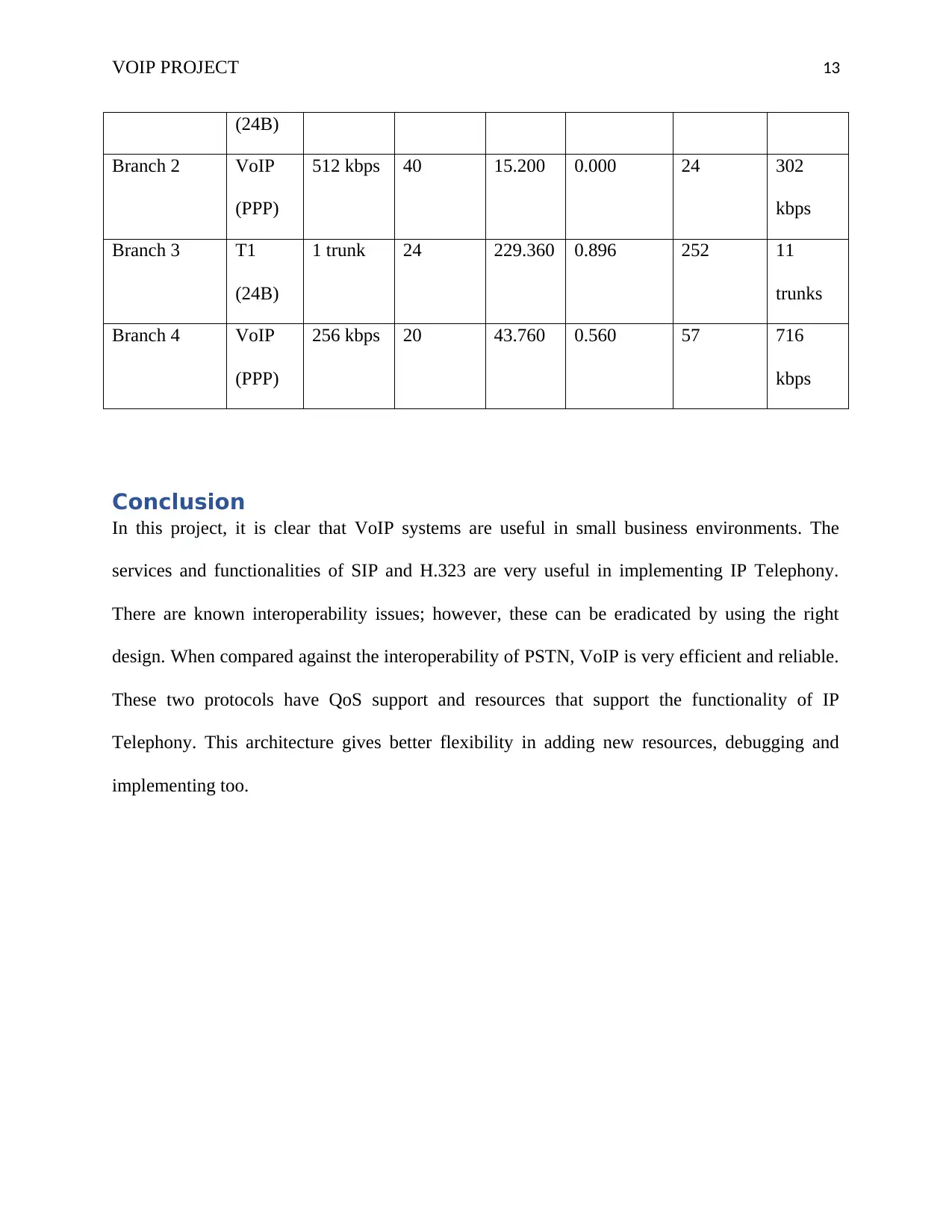
VOIP PROJECT 13
(24B)
Branch 2 VoIP
(PPP)
512 kbps 40 15.200 0.000 24 302
kbps
Branch 3 T1
(24B)
1 trunk 24 229.360 0.896 252 11
trunks
Branch 4 VoIP
(PPP)
256 kbps 20 43.760 0.560 57 716
kbps
Conclusion
In this project, it is clear that VoIP systems are useful in small business environments. The
services and functionalities of SIP and H.323 are very useful in implementing IP Telephony.
There are known interoperability issues; however, these can be eradicated by using the right
design. When compared against the interoperability of PSTN, VoIP is very efficient and reliable.
These two protocols have QoS support and resources that support the functionality of IP
Telephony. This architecture gives better flexibility in adding new resources, debugging and
implementing too.
(24B)
Branch 2 VoIP
(PPP)
512 kbps 40 15.200 0.000 24 302
kbps
Branch 3 T1
(24B)
1 trunk 24 229.360 0.896 252 11
trunks
Branch 4 VoIP
(PPP)
256 kbps 20 43.760 0.560 57 716
kbps
Conclusion
In this project, it is clear that VoIP systems are useful in small business environments. The
services and functionalities of SIP and H.323 are very useful in implementing IP Telephony.
There are known interoperability issues; however, these can be eradicated by using the right
design. When compared against the interoperability of PSTN, VoIP is very efficient and reliable.
These two protocols have QoS support and resources that support the functionality of IP
Telephony. This architecture gives better flexibility in adding new resources, debugging and
implementing too.
Paraphrase This Document
Need a fresh take? Get an instant paraphrase of this document with our AI Paraphraser

VOIP PROJECT 14
References
1. Vaishnav, C. (2006), Voice over Internet Protocol (VoIP): The Dynamics of Technology and
Regulation, Massachusetts Institute of Technology.
2. Cisco Systems (2002), Understanding Voice over IP Protocols, Retrieved from
https://www.cisco.com/application/pdf/en/us/guest/tech/tk587/c1506/
ccmigration_09186a008012dd36.pdf
3. Desantis, M., (2006), Understanding Voice over Internet Protocol (VoIP), Retrieved from
https://www.us-cert.gov/sites/default/files/publications/understanding_voip.pdf
4. Gries, M., (2002), Voice over IP overview, UC Berkeley
5. Baron, D. (2005), SIP Basics, MIT, Retrieved from
http://web.mit.edu/sip/presentations/np119.pdf
References
1. Vaishnav, C. (2006), Voice over Internet Protocol (VoIP): The Dynamics of Technology and
Regulation, Massachusetts Institute of Technology.
2. Cisco Systems (2002), Understanding Voice over IP Protocols, Retrieved from
https://www.cisco.com/application/pdf/en/us/guest/tech/tk587/c1506/
ccmigration_09186a008012dd36.pdf
3. Desantis, M., (2006), Understanding Voice over Internet Protocol (VoIP), Retrieved from
https://www.us-cert.gov/sites/default/files/publications/understanding_voip.pdf
4. Gries, M., (2002), Voice over IP overview, UC Berkeley
5. Baron, D. (2005), SIP Basics, MIT, Retrieved from
http://web.mit.edu/sip/presentations/np119.pdf
1 out of 14
Related Documents
Your All-in-One AI-Powered Toolkit for Academic Success.
+13062052269
info@desklib.com
Available 24*7 on WhatsApp / Email
![[object Object]](/_next/static/media/star-bottom.7253800d.svg)
Unlock your academic potential
© 2024 | Zucol Services PVT LTD | All rights reserved.





